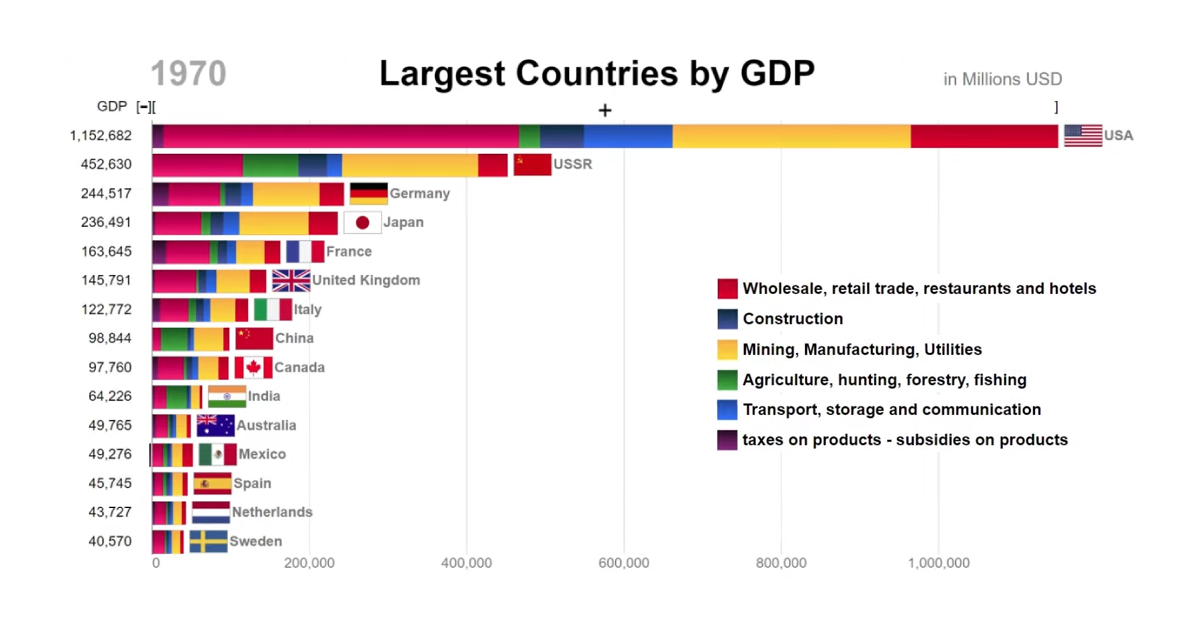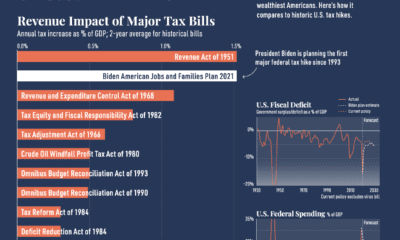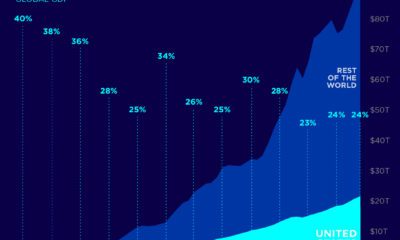Markets
Top Countries by GDP and Economic Components (1970-2017)
Countries by GDP and Economic Components (1970-2017)
While looking at the top countries by GDP is a useful big picture measure, it can also be informative to look at the components that make up an economy as well.
Examining a country’s economic building blocks can tell us a lot about what stage of development the country is in, and where competitive advantages may exist.
Analyzing GDP by Sector
Today’s “horse race” bar chart, by Number Story, is an entertaining historical look at the ranking of top countries by GDP, including the parts that make up the whole.
Here is the latest data as of 2018, as well as the largest sector according to data from the United Nations’ industry classification database:
| Rank | Country | GDP (2018) | Top Sector (% of total) | 2nd Largest Sector (% of total) |
|---|---|---|---|---|
| 1 | 🇺🇸 United States | $20.6T | Other (55%) | Mining/Manufacturing/Utilities (15%) |
| 2 | 🇨🇳 China | $13.6T | Other (36%) | Mining/Manufacturing/Utilities (33%) |
| 3 | 🇯🇵 Japan | $4.9T | Other (43%) | Mining/Manufacturing/Utilities (23%) |
| 4 | 🇩🇪 Germany | $3.6T | Other (48%) | Mining/Manufacturing/Utilities (25%) |
| 5 | 🇬🇧 UK | $2.5T | Other (55%) | Retail/Restaurant/Hotels (14%) |
| 6 | 🇮🇳 India | $2.5T | Other (36%) | Mining/Manufacturing/Utilities (22%) |
| 7 | 🇫🇷 France | $2.5T | Other (56%) | Mining/Manufacturing/Utilities (13%) |
| 8 | 🇮🇹 Italy | $1.9T | Other (49%) | Mining/Manufacturing/Utilities (20%) |
| 9 | 🇧🇷 Brazil | $1.6T | Other (50%) | Mining/Manufacturing/Utilities (16%) |
| 10 | 🇨🇦 Canada | $1.6T | Other (52%) | Mining/Manufacturing/Utilities (18%) |
| 11 | 🇰🇷 South Korea | $1.6T | Other (42%) | Mining/Manufacturing/Utilities (31%) |
| 12 | 🇷🇺 Russia | $1.5T | Other (36%) | Mining/Manufacturing/Utilities (28%) |
| 13 | 🇦🇺 Australia | $1.4T | Other (53%) | Mining/Manufacturing/Utilities (17%) |
| 14 | 🇪🇸 Spain | $1.3T | Other (47%) | Retail/Restaurant/Hotels (19%) |
| 15 | 🇲🇽 Mexico | $1.2T | Other (34%) | Mining/Manufacturing/Utilities (24%) |
Why are “Other Activities” so dominant in this breakdown?
It’s because of the way GDP that components are classified as data in the UN industry classification system, which is laid out below:
- Agriculture, hunting, forestry, fishing (ISIC A-B)
- Mining, manufacturing, utilities (ISIC C-E)
- Construction (ISIC F)
- Wholesale, retail trade, restaurants and hotels (ISIC G-H)
- Transport, storage and communication (ISIC I)
- Other activities, such as finance, healthcare, real estate, and tech (ISIC J-P)
Although agriculture, construction, or manufacturing have been a bedrock for economies in the past, developed countries skew towards adding economic value in different ways today.
Given that finance, government spending (healthcare, education, defense, etc.) and technology — all important modern industries — are included in “Other”, this makes the possibly outdated classification the biggest (and least useful) category to examine here.
Nevertheless, there is still information we can glean from this animated breakdown of GDP, spanning a period of almost 50 years.
A More Granular Look at GDP
In the past, we’ve shown you high level visualizations that break down the world’s $86 trillion GDP by country, or even projections on the largest countries by GDP in 2030 in PPP terms.
However, the animated bar chart shows something more granular that is compelling in its own right. By observing the evolution of countries’ economic components over time, some interesting observations emerge that would normally be lost in the big picture.
Japan’s Manufacturing Boom
At points during Japan’s heyday of growth during the 1980’s, manufacturing comprised nearly 30% of economic activity. By the mid-90s, this single segment of Japan’s economy was so valuable that, on its own, it would’ve placed fifth in the global ranking.
America Leading the Pack
While other countries switch positions, reordering as economies boom and bust, the U.S. has handily remained in top position.
Japan was the country that narrowed the gap between the first and second spot the most, though the country’s Lost Decade in the 1990s cut that ascension short.
During the years between 1970 and 2017, the United States was at its most dominant in 2006 when its GDP was triple the size of Japan’s. Of course, in recent years China has narrowed the gap considerably.
A Star Rising in the East
As one would expect, the building blocks of China’s economy looked very different in the 1970s than today.
The communist systems of the USSR and China are both easy to spot in the visualization. Agriculture played an outsized role, and industries like finance, real estate, and retail were understated compared to the profiles of countries that operated under a capitalist system.
In 1980, as the first Special Economic Zones were being created, three-quarters of China’s economy was based on agriculture, resource extraction, and manufacturing. Even as recently as the early ’90s, China wasn’t in the top 10 despite being the world’s most populous country.
Of course, that situation changed drastically over the next two decades. By the dawn of the 21st century, China ranked fifth in the world, and a decade later, China surpassed Japan to become the second largest economy globally.
Markets
The European Stock Market: Attractive Valuations Offer Opportunities
On average, the European stock market has valuations that are nearly 50% lower than U.S. valuations. But how can you access the market?

European Stock Market: Attractive Valuations Offer Opportunities
Europe is known for some established brands, from L’Oréal to Louis Vuitton. However, the European stock market offers additional opportunities that may be lesser known.
The above infographic, sponsored by STOXX, outlines why investors may want to consider European stocks.
Attractive Valuations
Compared to most North American and Asian markets, European stocks offer lower or comparable valuations.
| Index | Price-to-Earnings Ratio | Price-to-Book Ratio |
|---|---|---|
| EURO STOXX 50 | 14.9 | 2.2 |
| STOXX Europe 600 | 14.4 | 2 |
| U.S. | 25.9 | 4.7 |
| Canada | 16.1 | 1.8 |
| Japan | 15.4 | 1.6 |
| Asia Pacific ex. China | 17.1 | 1.8 |
Data as of February 29, 2024. See graphic for full index names. Ratios based on trailing 12 month financials. The price to earnings ratio excludes companies with negative earnings.
On average, European valuations are nearly 50% lower than U.S. valuations, potentially offering an affordable entry point for investors.
Research also shows that lower price ratios have historically led to higher long-term returns.
Market Movements Not Closely Connected
Over the last decade, the European stock market had low-to-moderate correlation with North American and Asian equities.
The below chart shows correlations from February 2014 to February 2024. A value closer to zero indicates low correlation, while a value of one would indicate that two regions are moving in perfect unison.
| EURO STOXX 50 | STOXX EUROPE 600 | U.S. | Canada | Japan | Asia Pacific ex. China |
|
|---|---|---|---|---|---|---|
| EURO STOXX 50 | 1.00 | 0.97 | 0.55 | 0.67 | 0.24 | 0.43 |
| STOXX EUROPE 600 | 1.00 | 0.56 | 0.71 | 0.28 | 0.48 | |
| U.S. | 1.00 | 0.73 | 0.12 | 0.25 | ||
| Canada | 1.00 | 0.22 | 0.40 | |||
| Japan | 1.00 | 0.88 | ||||
| Asia Pacific ex. China | 1.00 |
Data is based on daily USD returns.
European equities had relatively independent market movements from North American and Asian markets. One contributing factor could be the differing sector weights in each market. For instance, technology makes up a quarter of the U.S. market, but health care and industrials dominate the broader European market.
Ultimately, European equities can enhance portfolio diversification and have the potential to mitigate risk for investors.
Tracking the Market
For investors interested in European equities, STOXX offers a variety of flagship indices:
| Index | Description | Market Cap |
|---|---|---|
| STOXX Europe 600 | Pan-regional, broad market | €10.5T |
| STOXX Developed Europe | Pan-regional, broad-market | €9.9T |
| STOXX Europe 600 ESG-X | Pan-regional, broad market, sustainability focus | €9.7T |
| STOXX Europe 50 | Pan-regional, blue-chip | €5.1T |
| EURO STOXX 50 | Eurozone, blue-chip | €3.5T |
Data is as of February 29, 2024. Market cap is free float, which represents the shares that are readily available for public trading on stock exchanges.
The EURO STOXX 50 tracks the Eurozone’s biggest and most traded companies. It also underlies one of the world’s largest ranges of ETFs and mutual funds. As of November 2023, there were €27.3 billion in ETFs and €23.5B in mutual fund assets under management tracking the index.
“For the past 25 years, the EURO STOXX 50 has served as an accurate, reliable and tradable representation of the Eurozone equity market.”
— Axel Lomholt, General Manager at STOXX
Partnering with STOXX to Track the European Stock Market
Are you interested in European equities? STOXX can be a valuable partner:
- Comprehensive, liquid and investable ecosystem
- European heritage, global reach
- Highly sophisticated customization capabilities
- Open architecture approach to using data
- Close partnerships with clients
- Part of ISS STOXX and Deutsche Börse Group
With a full suite of indices, STOXX can help you benchmark against the European stock market.

Learn how STOXX’s European indices offer liquid and effective market access.

-

 Economy1 day ago
Economy1 day agoEconomic Growth Forecasts for G7 and BRICS Countries in 2024
The IMF has released its economic growth forecasts for 2024. How do the G7 and BRICS countries compare?
-

 Markets1 week ago
Markets1 week agoU.S. Debt Interest Payments Reach $1 Trillion
U.S. debt interest payments have surged past the $1 trillion dollar mark, amid high interest rates and an ever-expanding debt burden.
-

 United States2 weeks ago
United States2 weeks agoRanked: The Largest U.S. Corporations by Number of Employees
We visualized the top U.S. companies by employees, revealing the massive scale of retailers like Walmart, Target, and Home Depot.
-

 Markets2 weeks ago
Markets2 weeks agoThe Top 10 States by Real GDP Growth in 2023
This graphic shows the states with the highest real GDP growth rate in 2023, largely propelled by the oil and gas boom.
-

 Markets2 weeks ago
Markets2 weeks agoRanked: The World’s Top Flight Routes, by Revenue
In this graphic, we show the highest earning flight routes globally as air travel continued to rebound in 2023.
-

 Markets2 weeks ago
Markets2 weeks agoRanked: The Most Valuable Housing Markets in America
The U.S. residential real estate market is worth a staggering $47.5 trillion. Here are the most valuable housing markets in the country.
-

 Mining1 week ago
Mining1 week agoGold vs. S&P 500: Which Has Grown More Over Five Years?
-

 Markets2 weeks ago
Markets2 weeks agoRanked: The Most Valuable Housing Markets in America
-

 Money2 weeks ago
Money2 weeks agoWhich States Have the Highest Minimum Wage in America?
-

 AI2 weeks ago
AI2 weeks agoRanked: Semiconductor Companies by Industry Revenue Share
-

 Markets2 weeks ago
Markets2 weeks agoRanked: The World’s Top Flight Routes, by Revenue
-

 Demographics2 weeks ago
Demographics2 weeks agoPopulation Projections: The World’s 6 Largest Countries in 2075
-

 Markets2 weeks ago
Markets2 weeks agoThe Top 10 States by Real GDP Growth in 2023
-

 Demographics2 weeks ago
Demographics2 weeks agoThe Smallest Gender Wage Gaps in OECD Countries







